|
|
 |
Fiche d'espèce de Copépode |
|
|
Cyclopoida ( Ordre ) |
|
|
|
Oithonidae ( Famille ) |
|
|
|
Oithona ( Genre ) |
|
|
| |
Oithona fallax Farran, 1913 (F,M) | |
| | | | | | | Ref.: | | | Farran, 1913 a (p.185, Descr.F, figs.F); Rosendorn, 1917 (p.303); 1917 a (p.27, Descr. F, M, figs.F,M); Früchtl, 1924 b (p.66); Kiefer, 1929 g (p.7, Rem.F,M); Mori, 1937 (1964) (p.112, figs.F); Sewell, 1947 (p.253, Rem.F); Lindberg, 1955 a (p.465: Rem.); Chiba & al., 1957 (p.310); 1957 a (p.12); Tanaka, 1960 (p.57, figs.M, Rem.); Fagetti, 1962 (p.38); Wellershaus, 1970 (p.482: Rem.F,M); Chen & al., 1974 (p.31, figs.F,M, p.74: Rem.), Tab.1; Nishida & al., 1977 (p.134, figs.F,M, Rem.); Shuvalov, 1980 (p.123, figs.F,M); Zheng & al., 1982 [p.96, Figs.F); Nishida, 1985 a (p.42, figs.F, Rem.: p.128); Yoo & Lim, 1993 (p.91, 94, 98, Tazble 1fig.2); Kim & al., 1993 (p.271); Chihara & Murano, 1997 (p.937, Pl.194, 200: F,M); Bradford-Grieve & al., 1999 (p.886, 966, figs.F); McKinnon, 2000 (p.108, Rem.); Conway & al., 2003 (p.203, figs.F,M, Rem.); Vives & Shmeleva, 2010 (p.58, figs.F,M, Rem.) | 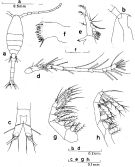 Issued from : S. Nishida in Bull. Ocean Res. Inst., Univ. Tokyo, 1985, No 20. [p.43, Fig.19]. Female: a, habitus (dorsal); b, forehead (lateral); c, anal segment and caudal rami (dorsal); d, A1; e, Md; f, Md (biting edge); g, Mx2; h, Mxp. Nota: Proportional lengths of urosome segments and caudal ramus 14:32:15:15:13:11.
|
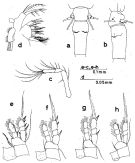 Issued from : S. Nishida in Bull. Ocean Res. Inst., Univ. Tokyo, 1985, No 20. [p.44, Fig.20]. Female: a, thoracic segment 5 and genital segment (dorsal); b, idem (lateral right side); c, A2; d, Mx1; e, P1; f, P2; g, P3; h, P4. Nota: Inner margin of the exopodal segment 1 of P1 with 1 seta. Endopodite of Mx1 with 0 seta from Indian Ocean and Equatorial Pacific (1 seta in Nishida & al., 1977 from Coast of Japan, and other authors). after C.R.: Setal formula on outer margin (in first) and inner margin (in second) of exopod segments (from proximal to distal) of P1 to P4: P1: 1, 1, 2; 1, 1, 4. P2: 1, *, 2; 1, 1, 5 P3: 1, *, * 1; 1, 1, 5. P4: 0, 0, 1; 0, 1, 5. * = very tiny spine.
|
 Issued from : S. Nishida in Bull. Ocean Res. Inst., Univ. Tokyo, 1985, No 20. [p.42, Table 3]. Number of setae on inner margin of exopodite of P1 and endopodite of Mx1 of female Oithona fallax reported by workers.
|
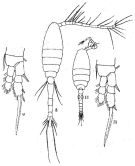 issued from : Q.-c Chen & S.-z. Zhang & C.-s. Zhu in Studia Marina Sinica, 1974, 9. [Pl.1, Figs.8-11]. Female (from China Seas): 8, habitus (dorsal); 9, P2; 10, P3. Nota: Farran (1913) reported that the exopod 3 of P4 is witout an outer spine, but it is present in our specimens. Male: 11, habitus (dorsal). Nota: Our male individuals agree well with the Rosendorn's (1917) description.
|
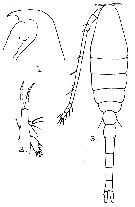 issued from : G.P. Farran in Proc. zool. Soc. Lond., 1913. [Plate XXVIII, Figs.1-3]. Female (from Christmas Island, Indian): 1, forehead (lateral); 2, Md (mandibular palp); 3, habitus (dorsal).
|
 issued from : G.P. Farran in Proc. zool. Soc. Lond., 1913. [Plate XXVII, Figs.9-12]. Female (from Christmas Island, Indian): 9-12, P1 to P4.
|
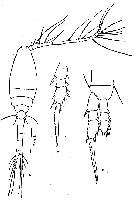 issued from : Z. Zheng, S. Li, S.J. Li & B. Chen in Marine planktonic copepods in Chinese waters. Shanghai Sc. Techn. Press, 1982 [p.97, Fig.56]. Female: a, habitus (dorsal); b, exopod of P2; c, P3. Scale bar in mm.
|
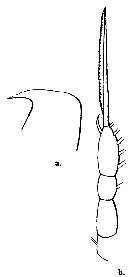 issued from : I. Rosendorn in Wiss. Ergebn. dt. Tiefsee-Exped. \"Valdiviella\", 1917, 23. [p.28, Fig.14]. Female: a, forehead (lateral); b, P4. Nota: Proportion of lengths (p.cent) Prosome : 52.81, Urosome : 47.19 . Relative lengths of urosomal segments and caudal rami: 8 : 16 : 8 : 8 : 7 : 5 . Setal formula of the exopod swimming legs P1 to P4 (Se = outer setae ; Si = inner setae), P1 : 1, 1, 2 Se ; 0, 1, 4 Si ; P2 : 1, 0, 2 Se ; 0, 1, 5 Si ; P3 : 1, 0, 1 Se ; 1, 1, 5 Si ; P4 : 0, 0, 1 Se ; 0, 1, 5 Si .
|
 issued from : I. Rosendorn in Wiss. Ergebn. dt. Tiefsee-Exped. \"Valdiviella\", 1917, 23. [p.29, Fig.15]. Male: a, habitus (dorsal); b, urosome; c, right A1; d, Md (mandibular palp); e, P1; f, P2; g, P3; h, P4. Nota: Proportion of lengths (p.cent) Prosome : 59.70, Urosome : 40.30 . Relative lengths of urosomal segments and caudal rami: 7 : 16 : 10 : 9 : 6 : 6: 7. Setal formula of the exopod swimming legs P1 to P4 (Se = outer setae ; Si = inner setae), P1 : 1, 1, 2 Se ; 0, 1, 4 Si ; P2 : 1, 1, 3 Se ; 1, 1, 5 Si ; P3 : 1, 1, 2 Se ; 1, 1, 5 Si ; P4 : 1, 1, 2 Se ; 0, 1, 5 Si. Setal formula in Vives & Shmeleva (2010, p.59) for P1: 1, 1, 2 Se; 1, 1, 4 Si.
|
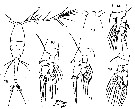 issued from : T. Mori in The Pelagic copepoda from the neighbouring waters of Japan, 1937 (1964). [Pl. 62, Figs.13-18.]. Female: 13, forehead (dorsal); 14, P1; 15, habitus (dorsal); 16, P2; 17, P3; 18, P4.
|
 issued from : V.S. Shuvalov in Opred. Faune SSSR, Nauka, Leningrad, 1980, 125. [p.121, Fig.27, 1-9]. Female: 1-2, habitus (dorsal and lateral, respectively); 3, cephalon (dorsal); 4, habitus (dorsal); 5, A1; 6, forehead (lateral); 7-8, thoracic segment 5 and genital segment (dorsal and lateral, respectively); 9, posterior part of urosome (dorsal).
|
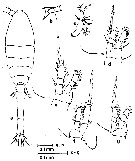 Issued from : S. Nishida, O. Tanaka & M. Omori in Bull. Plankton Soc. Japan, 1977, 24 (2). [p.135, Fig.8]. Female (from Suruga Bay and adjacent waters): a, habitus (dorsal), b, forehead (lateral); c, Md; d, P1; e, P2; f, P3; g, P4.P1: 1,1,2; 1,1,4. P2: 1,0,2; 1,1,5. P3: 1,0,1; 1,1,5. P4: 0,0,1; 1,1,5. Exopodite 3 of P2-P3 with a tooth on the outer margin. Prosome length/urosome length = 1.30-1.32.
|
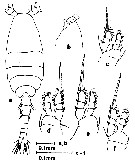 Issued from : S. Nishida, O. Tanaka & M. Omori in Bull. Plankton Soc. Japan, 1977, 24 (2). [p.136, Fig.9]. Male (from Suruga Bay and adjacent waters): a, habitus (dorsal), b, forehead (lateral); c,P1; d, P2; e, P3; f, P4. Nota: Setae formula of exopod P1 to P4 (outer setae in first, inner setae in second). P1: 1,1,2; 1,1,4. P2: 1,1,3; 1,1,5. P3: 1,1,2; 1,1,5. P4: 1,1,2; 1,1,5. Outer margin of exopod segments 2 and 3 of P2-P3 with small teeth. Prosome length/urosome length = 1.75.
|
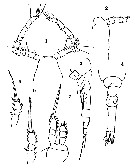 Issued from : O. Tanaka in Spec. Publs. Seto mar. biol. Lab., 10, 1960 [Pl. XXV, 1-7]. Male (from Indian Ocean): 1, head (dorsal) ; 2, forehead (lateral); 3, urosome (lateral); 4, same (dorsal); 5, exopod of P1; 6, exopod of P3; 7, P4. Nota: Proportional lengths prosome and urosome 62 to 38. Rostrum not visible from the dorsal, represented by a blunt process in lateral view. Urosomal segments and caudal rami in the proportional lengths 19 : 21 : 16 : 13 : 10 : 11 : 10 = 100.
|
 Issued from : O. Tanaka in Spec. Publs. Seto mar. biol. Lab., 10, 1960 [p.58]. Male: Number of outer marginal spine and inner marginal setae on the exopodal segments from P1 to P4. Nota: The present male agrees fairly well with that described by Rosendorn except the number of outer marginal spines on P2 to P4. Also, note the differences in setal formula between Tanaka and Nishida & al.
|
 Issued from K.-I. & D.-H. Lim in The Korean J. Syst. Zool., 1993, 9 (2). [Key of female]: ]Morphological characters of Oithona fallax female in Korean waters :
1 - Anterior part of prosome rounded in dorsal view.
2 - Rostrum pointed ventrally. 3 - Length of A1 longer than that of prosome. 4 - Exopod 2nd segment of P1 with 1 spine. 5 - Exopod 3rd segment of P2 with 2 spines.
|
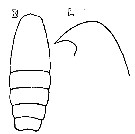 Issued from : K.-I. Yoo & D.-H. Lim in The Korean J. Syst. Zool., 1993, 9 (2) [p.99, Fig.2, B, L] Female (from Korean Waters): B, prosome (dorsal); L, forehead and rostrum (lateral view).
| | | | | Ref. compl.: | | | Wilson, 1942 a (p.196); Sewell, 1948 (p.420, 431); Yamazi, 1958 (p.153, Rem., as O. farax); Unterüberbacher, 1964 (p.32); De Decker, 1964 (p.16, 23, 29); De Decker & Mombeck, 1964 (p.13); Pavlova, 1966 (p.44); Kovalev & Shmeleva, 1982 (p.85); Binet, 1984 (tab.3); Greze & al., 1985 (p.8); Hernandez-Trujillo, 1989 a (tab.1); Cervantes-Duarte & Hernandez-Trujillo, 1989 (tab.3); Yoo, 1991 (tab.1); Hernandez-Trujillo, 1991 (1993) (tab.I); McKinnon, 1991 (p.471); Shih & Young, 1995 (p.74); Park & Choi, 1997 (Appendix); Noda & al., 1998 (p.55, Table 3, occurrence); Suarez-Morales & Gasca, 1998 a (p.111); Siokou-Frangou, 1999 (p.478); Hernandez-Trujillo, 1999 (p.284, tab.1); Razouls & al., 2000 (p.343, Appendix); Ueda & al., 2000 (tab.1); Fernandez-Alamo & al., 2000 (p.1139, Appendix); Suarez-Morales & al., 2000 (p.751, tab.1); Hernandez-Trujillo & Suarez-Morales, 2002 (p.748, tab.1); Uysal & al., 2002 (p.18, tab.1); Hsieh & al., 2004 (p.398, tab.1); Wang & Zuo, 2004 (p.1, Table 2, dominance, origin); Lan & al., 2004 (p.332, tab.1); Lo & al., 2004 (p.89, tab.1); Hwang & al., 2005 (p.106); Prusova & Smith, 2005 (p.76); Zuo & al., 2006 (p.159, tab.1, abundance, fig.8:stations group); Hwang & al., 2006 (p.943, tabl. I); Ayon & al., 2008 (p.238, Table 4: Peruvian samples); McKinnon & al., 2008 (p.843: Tab.1); Lan Y.-C. & al., 2008 (p.61, Table 1, % vs stations); Tseng L.-C. & al., 2008 (p.153, Table 2, occurrence vs geographic distribution); C.-Y. Lee & al., 2009 (p.151, Tab.2); J.-S. Hwang & al., 2010 (p.220, Fig.3, Table 2, %, abundance); Hernandez-Trujillo & al., 2010 (p.913, Table 2); Sun & al., 2010 (p.1006, Table 2); Fazeli & al., 2010 (p.153, Table 1); Hsiao S.H. & al., 2011 (p.475, Appendix I); Beltrao & al., 2011 (p.47, Table 1, density vs time); Uysal & Shmeleva, 2012 (p.909, Table I); Jang M.-C & al., 2012 (p.37, abundance and seasonal distribution); Palomares-Garcia & al., 2013 (p.1009, Table I, abundance vs environmental factors); in CalCOFI regional list (MDO, Nov. 2013; M. Ohman, comm. pers.); Tachibana & al., 2013 (p.545, Table 1, seasonal change 2006-2008); Tseng & al., 2013 (p.507, seasonal abundance); Rojas-Herrera & al., 2016 (p.40, Table 2: temporal abundance); Zakaria & al., 2016 (p.1, Table 1, Rem.); Palomares-Garcia & al., 2018 (p.178, Table 1: occurrence); | | | | NZ: | 16 | | |
|
Carte de distribution de Oithona fallax par zones géographiques
|
| | | | | | | | | | | | | | |  Issued from : S. Nishida in Bull. Ocean Res. Inst., Univ. Tokyo, 1985, No 20. [p.128, Fig.77]. Issued from : S. Nishida in Bull. Ocean Res. Inst., Univ. Tokyo, 1985, No 20. [p.128, Fig.77].
Indo-Pacific geographical distribution of Oithona fallax. |
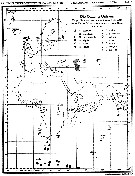 issued from : I. Rosendorn in Wiss. Ergebn. dt. Tiefsee-Exped. "Valdiviella", 1917, 23. [Taf. I]. issued from : I. Rosendorn in Wiss. Ergebn. dt. Tiefsee-Exped. "Valdiviella", 1917, 23. [Taf. I].
The genus Oithona: Distribution of species sampled during the Deutsche Tiefsee Expedition 1898-99.
The size of symbols indicates the relative quantitty of the species. |
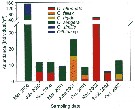 Issued from : J.-S. Hwang, R. Kumar, H.-U. Dahms, L.-C. Tseng & Q.-C. Chen in Zool. Studies, 49 (2). [p.224, Fig.3). Issued from : J.-S. Hwang, R. Kumar, H.-U. Dahms, L.-C. Tseng & Q.-C. Chen in Zool. Studies, 49 (2). [p.224, Fig.3).
Average abundances of six Oithona species recorded in the South China Sea from Mar. 2000 to Oct. 2002.
Sampling stations between 16-24° N, 114-120° E. |
| | | | Loc: | | | sub-Antarct. (Se Atlant.), South Africa (E & W), Namibia, G. of Guinea, Ibero-moroccan Bay, Medit. (Alboran Sea, W Basin, G. of Saronikos, Aegean Sea, W Egyptian coast, Lebanon Basin), Red Sea, Gulf of Oman, Arabian Sea, W Indian, Christmas Is., Aru Is., China Seas (Yellow Sea, East China Sea, South China Sea), Taiwan (E, W, NW, N, NE, Mienhua Canyon), S & E Korea, Korea Strait, Japan, Kuchinoerabu Is., Ariake Bay, Tanabe Bay, Tokyo Bay, New Caledonia, W & E Australia (North West Cape, Great Barrier), Pacif. (equatorial), W BaJa California (Bahia Magdalena), La Paz, Gulf of California (rare), W Mexico, Acapulco Bay (very rare), G. of Tehuantepec, Peru, Chile | | | | N: | 74 | | | | Lg.: | | | (11) F: 0,87; (66) M: 0,66; (91) F: ± 0,86; (109) F: 0,86-0,78; M: 0,64-0,55; (155) F: 1,01-0,88; M: 0,77; (432) F: 0,64-0,62; (627) F: 0,96-0,85; (634) F: 0,94-0,88; (649) F: 0,89; M: 0,67; (880) F: 0,84-0,89; M: 0,66-0,67; (991) F: 0,85-0,96; M: 0,67; (1023) F: 0,86-0,89; (1239) F: 0,88-1,04; {F: 0,62-1,04; M: 0,55-0,77} | | | | Rem.: | épipélagique - ?
Voir aussi les remarques en anglais | | | Dernière mise à jour : 09/12/2020 | |
|
|
 Toute utilisation de ce site pour une publication sera mentionnée avec la référence suivante : Toute utilisation de ce site pour une publication sera mentionnée avec la référence suivante :
Razouls C., Desreumaux N., Kouwenberg J. et de Bovée F., 2005-2025. - Biodiversité des Copépodes planctoniques marins (morphologie, répartition géographique et données biologiques). Sorbonne Université, CNRS. Disponible sur http://copepodes.obs-banyuls.fr [Accédé le 03 décembre 2025] © copyright 2005-2025 Sorbonne Université, CNRS
|
|
 |
 |




















